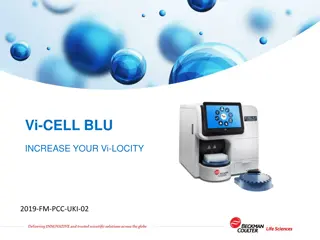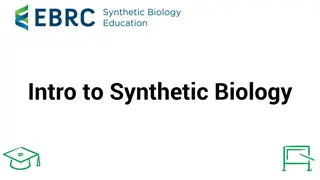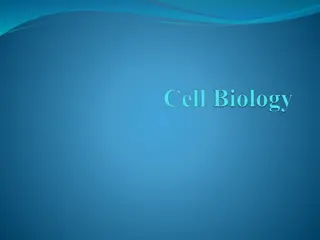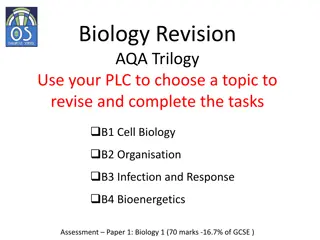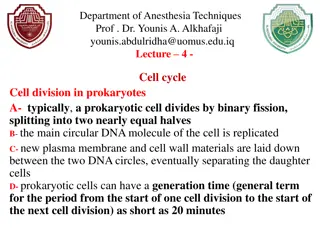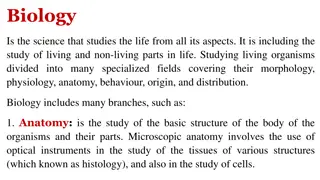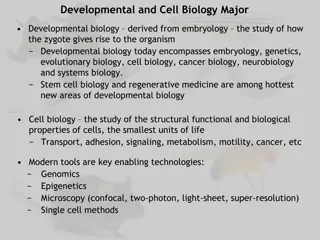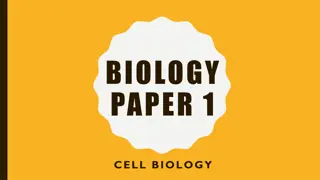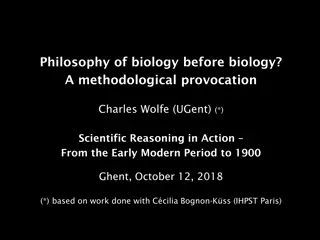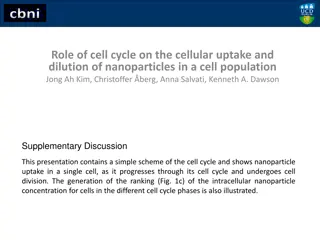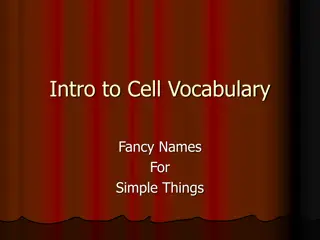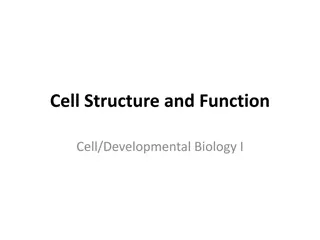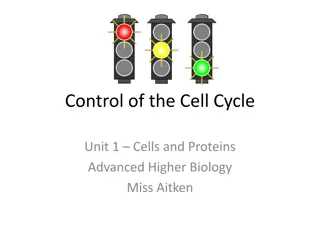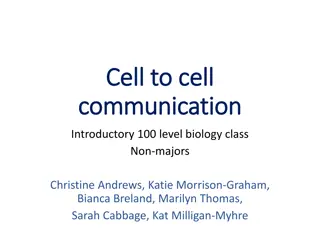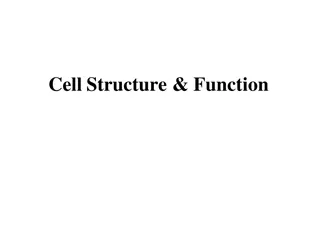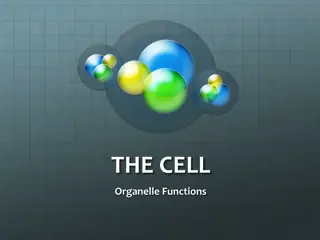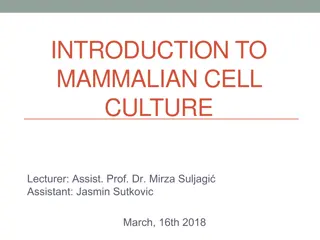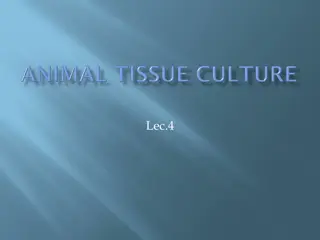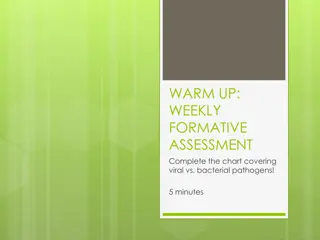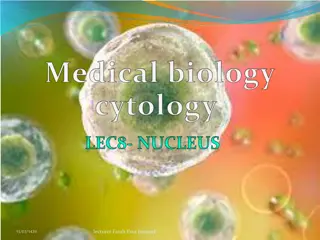Basics of Cell Biology Illustrated
This collection of informative cartoons covers various fundamental concepts in cell biology, including protein synthesis in ribosomes, energy conversion in mitochondria, organelle functions like the Golgi apparatus and lysosomes, cell theory principles, plant cell organelles, levels of organization, and processes like osmosis and facilitated diffusion.
Download Presentation

Please find below an Image/Link to download the presentation.
The content on the website is provided AS IS for your information and personal use only. It may not be sold, licensed, or shared on other websites without obtaining consent from the author.If you encounter any issues during the download, it is possible that the publisher has removed the file from their server.
You are allowed to download the files provided on this website for personal or commercial use, subject to the condition that they are used lawfully. All files are the property of their respective owners.
The content on the website is provided AS IS for your information and personal use only. It may not be sold, licensed, or shared on other websites without obtaining consent from the author.
E N D
Presentation Transcript
1 2 3 4 5 6 7 8 9 10 11 12 13 14 15 16 17 18 19 20 21 22 23 24 25 26 27 28 29 30 31 32 33 34 35 36 37 38 39 40 41 42 43 44 45 46 47 48 49 50 51 52 53 54 55 56 57 58 59 60 61 62 63 64
Protein synthesis takes place in the ribosomes Cartoon Penguin Clip Art
In eukaryotic cells the chemical energy stored in food is changed into ATP in the mitochondria Cartoon Penguin Clip Art
The organelle that modifies and packages is the Golgi apparatus Cartoon Penguin Clip Art
The small, membrane-bound structures that contain powerful digestive enzymes are Lysosomes Cartoon Penguin Clip Art
Cells that do not have a nucleus and membrane-bound organelles are called prokaryotic Cartoon Penguin Clip Art
The cell theory states that: all living things are composed of cells, cells are the basic unit of structure and function, and All cells come from pre- existing cells Cartoon Penguin Clip Art
Two organelles that are found in plant cells but not in animal cells are Cell wall and chloroplast Cartoon Penguin Clip Art
What are the four levels of organization from simplest to most complex? Cell, tissue, organ, organ system Cartoon Penguin Clip Art
The movement of water across a cell membrane from high to low concentration is called osmosis Cartoon Penguin Clip Art
Facilitated diffusion across cell membrane requires_______________ and moves a substance _________________________________. from a high to a low concentration proteins Cartoon Penguin Clip Art
An animal cell placed in a hypotonic solution would swell and eventually burst Cartoon Penguin Clip Art
Placing a plant in salt water solution would cause the cell contents to shrink away from the cell wall Cartoon Penguin Clip Art
Molecules that are too large to diffuse across a cell membrane can be exported by exocytosis Cartoon Penguin Clip Art
As a result of diffusion, the concentration of many types of substances is trying to reach equilibrium Cartoon Penguin Clip Art
Passive transport is the net movement of molecules from a higher to a lower concentration. Does not require energy! Cartoon Penguin Clip Art
How are ADP and ATP related? Di has 2 phosphates Tri has 3 phosphates ADP = half charged battery ATP = full charged battery Cartoon Penguin Clip Art
The two major groups of reactions used in photosynthesis are known as the light dependent reaction and the light independent reaction (Calvin/Dark cycle) Cartoon Penguin Clip Art
What organism can convert light into chemical energy? plants Cartoon Penguin Clip Art
What are the products of aerobic respiration? ATP, carbon dioxide and water Cartoon Penguin Clip Art
Which two substances must be present in the cell for the process of aerobic respiration to take place? glucose, oxygen Cartoon Penguin Clip Art
Both anaerobic respiration and aerobic respiration begin with the process of glycolysis Cartoon Penguin Clip Art
The two main types of fermentation are alcoholic and lactic acid fermentation Cartoon Penguin Clip Art
What process produces the greatest quantity of ATP per glucose molecule? aerobic respiration (ETC) Cartoon Penguin Clip Art
The process of mitotic cell division normally results in the production of Two cells with the same number of chromosomes as the parent cell Cartoon Penguin Clip Art
During which stage of the cell cycle does DNA replication occur? Interphase (S-phase) Cartoon Penguin Clip Art
The purpose of meiosis is to form four haploid cells (sex cells) Cartoon Penguin Clip Art
If a body cell of an alligator has 32 chromosomes how many chromosomes would there be in an alligator s sperm cell? 16 Cartoon Penguin Clip Art
During crossing-over, portions of chromatids Break off and attach to adjacent chromatids on the homologous chromosome Cartoon Penguin Clip Art
The primary function of DNA in cells is to Store and transmit information Cartoon Penguin Clip Art
What are the three components of a nucleotide? Five-carbon sugar, phosphate group and nitrogen base Cartoon Penguin Clip Art
If one strand of DNA has a base sequence of ATCGT, the complementary base sequence is TAGCA Cartoon Penguin Clip Art
Guanine and cytosine are joined by weak hydrogen bonds Cartoon Penguin Clip Art
Where does transcription occur? nucleus Cartoon Penguin Clip Art
The function of mRNA is to carry genetic information from the nucleus to the ribosome Cartoon Penguin Clip Art
If the DNA code for the amino acid valine is CAA and the DNA code for the amino acid glycine is CCT, then the correct mRNA sequence for valine and then glycine is GUU - GGA Cartoon Penguin Clip Art
The order of the information flow for protein synthesis is DNA RNA protein trait Cartoon Penguin Clip Art
In messenger RNA, each codon specifies a particular amino acid Cartoon Penguin Clip Art
The product of translation is a sequence of amino acids held together by peptide bonds (protein) Cartoon Penguin Clip Art
Who is considered the father of genetics? Mendel Cartoon Penguin Clip Art
In guinea pigs, black fur (B) is completely dominant over white fur (b). In order to determine whether a black guinea pig is homozygous or heterozygous for the color trait, the guinea pig should be mated with a white guinea pig (homozygous) Cartoon Penguin Clip Art
In pea plants tall is completely dominant to short. Half of the offspring are short. What are the probable parental genotypes? Tt x tt Cartoon Penguin Clip Art
A segment of DNA on a chromosome that controls a particular hereditary trait is called a/an gene Cartoon Penguin Clip Art
True/False: A cell that lacks a nucleus and membrane bound organelles is called eukaryotic False Cartoon Penguin Clip Art
What is the correct sequence of events in embryonic development? zygote morula blastula gastrula Cartoon Penguin Clip Art
The attachment of the blastocyst (blastula) to the uterine wall is known as implantation Cartoon Penguin Clip Art
Three primary germ layers are produced during gastrulation Cartoon Penguin Clip Art
The first few mitotic cell divisions of the zygote are called cleavages Cartoon Penguin Clip Art
The structure that exchanges nutrients, gases and waste products between the mother and the fetus is the placenta Cartoon Penguin Clip Art
The stage of embryonic development that consists of a solid ball of cells is called a morula Cartoon Penguin Clip Art


